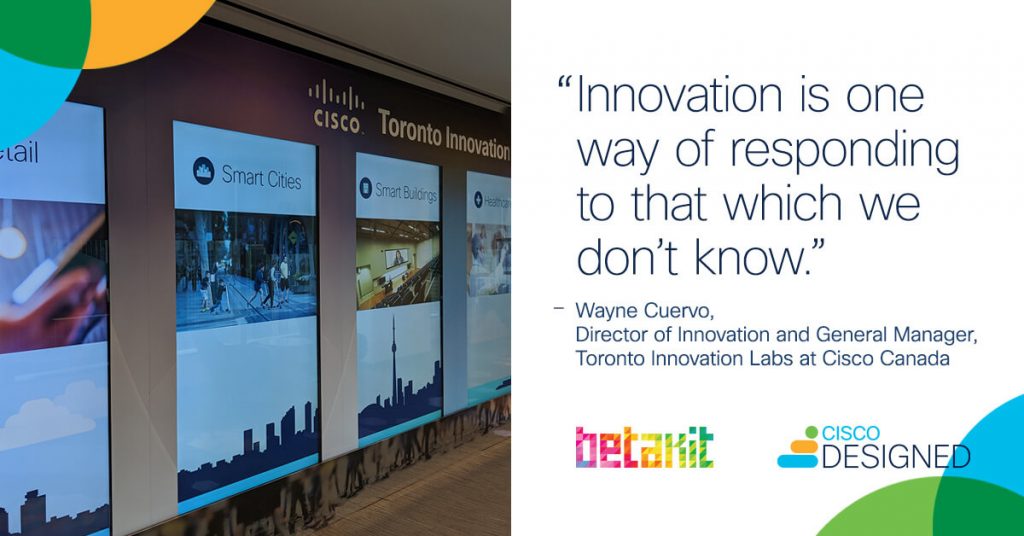The Cisco Designed Small Business Resiliency series shares stories and resources for businesses working to recover from the economic impact of COVID-19.
Startups are built to scale. They build a plan for growth, then test, iterate, and execute. The COVID-19 pandemic put forth a new reality: planning for survival. As startups work to survive the pandemic, leaders need to think not just about growth, but building resiliency into their business model to withstand the next potential shock.
Speaking with BetaKit, Wayne Cuervo, the Director of Innovation and General Manager of Cisco’s Toronto Innovation Labs, offered his advice on three pillars that startups need to be resilient and how innovation fits into the mix.
The three pillars of a resilient business
Instead of trying to cover for every possible threat, Cuervo advised startups to take a more foundational approach. Specifically, Cuervo advised startup leaders to construct a Business Continuity Plan supported by three core pillars.
The first pillar rests on the capacity of employees to work anywhere, something the pandemic showed many startups were not prepared for. This isn’t a debate about whether employees should operate remotely versus in an office, but enabling the ability to work from anywhere in case current working environments are no longer possible.
“More and more, we’re seeing work is an activity, not a place,” said Cuervo.
“More and more, we’re seeing work is an activity, not a place.”
The next pillar is ensuring the work environment, wherever it exists physically and online, is secure. Cybersecurity risks are compounded when businesses can’t control their physical environment as they could in an office, requiring greater cost and intention towards secure networks and device monitoring.
The other challenge with cybersecurity for startups, frankly, is ego. Many founders believe that hacks and data breaches are something only big companies face, but Cuervo warns against startups thinking they are immune to cybersecurity issues simply because they are small. While cyber-attacks on small businesses may not make the evening news, Cuervo said it’s still a huge issue, noting that “78 percent of small businesses have suffered cyber attacks.”
Another lesson harshly taught by COVID-19 is that no customer access point is sacred, which is why the third pillar to building startup resiliency is go-to-market flexibility. When the pandemic pushed everyone into their homes, many small businesses lost almost all foot traffic overnight, decimating sales. Technology companies with brick-and-mortar businesses as customers also suffered.
While having a primary go-to-market channel is not a bad thing, a strong Business Continuity Plan requires contingencies in place if that channel becomes unviable. This could mean a quick pivot or even an acquisition that helps you serve customers via new channels.
The key, Cuervo said, is making sure you have a plan that will get you to “whichever customer you’re serving.” This is something he has personal familiarity with, as the Toronto Innovation Labs specializes in helping partner startups with go-to-market support, whether that’s integrating startup technology into the Cisco stack or introducing startups to Cisco’s customer base.

Urgent vs. important
Having a plan that enables your business to work from anywhere, work securely, and access customers is one thing. Taking the correct actions in response to a crisis requires a new mental model of innovation.
In a crisis, businesses need to focus on critical tasks only. Cuervo said there are two levels of critical tasks that leaders need to assess: what’s urgent, which is usually directly tied to revenue, and what’s important, which is everything else that needs to be done in support of revenue.
According to Cuervo, only focusing on urgent revenue-related tasks is shortsighted. When dealing with both the important and the urgent, founders need to take a step back when prioritizing. It’s easy to jump into familiar habits, particularly around engrained processes or ways of work, because they are comfortable. However, Cuervo warns that rushing to action “does not always lead to the best outcome,” particularly in a crisis.
“Pause for a second to say ‘what else could I do that would be more efficient in terms of output, more speedy in terms of completion, or what would be most satisfying to my customer at this time?’” said Cuervo.
The simple question of what else you could do in a given situation will help develop new creative ideas, but startup leaders also need to focus on continued learning and self-education, said Cuervo. The problem many startup leaders face, though, is time. Particularly in a crisis, time is at a high premium, so Cuervo recommended learning “a little bit and often.”
“With an innovation culture you have to learn what works, what doesn’t, and not be bothered that you’ve spent time and resources, because it was learning,” said Cuervo. “You have to be able to pull the plug very quickly, but take and pivot the learnings into something else.”
It’s impossible to predict what could happen next. And because it’s impossible to predict what’s coming, there is no way to prepare for everything. Instead, startup leaders should focus on building resiliency into their business models, leveraging a mix of technology, process, and culture to do it. The result will not be the answer to every problem, but the ability to respond to whatever comes.


